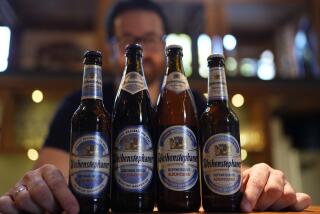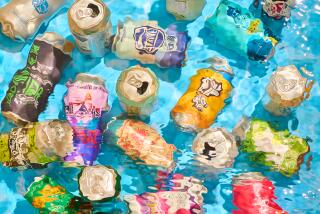Warming up to Belgian <i>wit bier</i>
- Share via
Beneath a big white head of foam, the beer in the glass isn’t clear yellow -- there’s a pearly haze to it. When you lift it to your lips, you get a whiff of sweet spice and oranges. On the palate, it signs off with a tart, yeasty twist.
What the heck is this? Some wacky West Coast experiment?
No, it’s a Belgian wit bier.
Lately, American beer lovers have been discovering the highly distinctive brews of Belgium. We’ve learned about its rich, strong abbey ales, dubbels and trippels, which are just the thing for autumn. Wit bier is Belgium’s light, quaffable warm-weather ale.
“They’re the very best summer beers,” says Sang Yoon, owner of Father’s Office in Santa Monica, “because a lot of them have a little acidity, a lemony-yeasty finish. They’re thirst-quenching -- they’re good outdoor beers, poolside beers.”
“The good ones are great on a summer’s day,” agrees David Farnworth, owner of Lucky Baldwins Pub in Pasadena, which specializes in Belgian beers.
The ideal witbier is hard to find because many brewers don’t present all the elegant nuance and balance the style is capable of. Still, there are a lot of attractive beers in the near vicinity of greatness. You can find wit biers in larger liquor stores; in general, a 750-ml or 22-ounce bottle sealed with a cork is a sign of a serious version.
As summer beers, wits go with the smells of hot pavement, new-mown grass, wet swimsuits and somebody firing up the barbecue. But they’re not just for quaffing; they’re food beers too. They go particularly well with chicken, seafood and salad. “Wits are great with sushi,” Yoon says.
Basically, wit bier is a light ale: light in hops, light in malt, light in alcohol -- generally around 4.5%. What keeps it from being insipid is a yeasty note, a sly bit of tartness and a touch of coriander and orange peel (surprisingly harmonious flavorings for beer). Some brewers throw in other flavorings such as lemon grass and licorice.
As such, it breaks a couple of beer rules. Most spiced beers are dark, malty and alcoholic, and they tend to use pie-type spices; wit bier is the reverse of all that.
Wit’s a wheat beer, but it has only a family resemblance to the Bavarian hefeweizen style that has become familiar in this country in recent years. Unlike those beers, it’s not just about banana and clove flavors, though they certainly show up. Nor is it like the distinctly sour weisse-style wheat beer preferred in Berlin. Wit bier is unique.
“When somebody asks us for a light beer,” Yoon says, “we steer them to a wit, because it’s real beer -- wits are low in alcohol, but they’re distinctive. They have a citrus flavor, sort of like lemon verbena, and a lot of interesting little characters, all subtle.”
You might think “wit bier” means wheat beer in Flemish. Actually, it means white beer. The beer is really a very pale yellow, sometimes with a hint of chartreuse, but it often does have a faintly whitish cast because there are live yeast in the bottle -- wit bier is “bottle conditioned,” like champagne.
The yeast also explains the vigorous, occasionally explosive head on a glass of wit. Traditionally, it’s sold in wine bottles with the cork secured by a champagne-type wire cage. Sometimes the cork will pop just as fiercely as a champagne cork too.
Another reason for the whitish cast is that 40% to 50% of the grain it’s made from is unmalted wheat (the rest is malted barley). This means there may be a tiny bit of starch floating in the beer, sometimes giving a perceptible grainy element among the spice, fruit and yeast flavors.
A ‘60s revival
THIS style of beer originated in the farm country east of Brussels in the Middle Ages. It died out during the 1950s craze for lager, but it was revived in 1966 by a local aficionado named Pierre Celis. When he opened the Hoegaarden brewery, the once highly local brew proved popular far beyond its original territory. Others profited more from Celis’ spadework than he did. Hoegaarden wit bier is now made by InBev, the international beer giant that also owns Beck’s, Bass Ale and Stella Artois.
As proof of how complete the wit revival has been in its home country, the Bavik brewery makes a brand called Wittekerke, which takes its name from a long-running Belgian soap opera, now in its 17th year. (In the show, the inhabitants of the village of Wittekerke hang out at their local pub and drink you-know-what brand of beer.)
Wit bier may not be a household name in this country yet, but a number of American craft breweries already produce beers in this style. The pioneer was Allagash Brewing in Portland, Maine, which has made the excellent Allagash White its flagship beer from the day it opened in 1995. It was not the first wit brewer in North America, though -- that was Brasserie Unibroue in Chambly, Quebec, which has been making Blanche de Chambly since 1992.
American breweries often take liberties with the style, such as pasteurizing the beer or not bottling with live yeast. In fairness, some Belgian breweries are messing with the style too. One makes a version from spelt, a strongly flavored primitive wheat popular with health foodies. At least two of them make wit bier as a dubbel, about 50% more alcoholic than the usual wit, inevitably adding sweet, malty character that is rather a violation of the wit aesthetic.
And there’s a raspberry-flavored Wittekerke Rosé, probably influenced by the German practice of adding raspberry syrup to Berliner weisse; many Europeans love this rosé wheat beer, however much wit purists may wince.
The beer industry clearly thinks that wit bier is going to be big in this country, as people look for a more flavorful alternative to light beer. More and more breweries have been making it, and not just tiny craft operations. Under the Blue Moon label, Coors is importing a Belgian style wheat beer made by its Canadian associate Molson. And when the upper Midwest cult brewery Leinenkugel, of Chippewa Falls, Wis., decided to enter the L.A. market this spring, it was with Sunset Wheat -- a wit, though nonclassical one, brewed lager-fashion, not like an ale.
Who knew there was a whole wit world out there? Wit and wild for summer.
More to Read
Eat your way across L.A.
Get our weekly Tasting Notes newsletter for reviews, news and more.
You may occasionally receive promotional content from the Los Angeles Times.










